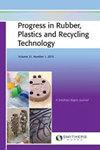废旧轮胎橡胶是一种回收材料,对其在单板层积板生产中的作用进行了研究
IF 1.6
4区 材料科学
Q4 MATERIALS SCIENCE, COMPOSITES
Progress in Rubber Plastics and Recycling Technology
Pub Date : 2021-06-08
DOI:10.1177/14777606211019408
引用次数: 1
摘要
随着世界人口的增加,人们产生的废物量也在增加。特别是不可回收的垃圾已经成为一个重大的环境问题。废轮胎是随着人们对汽车需求的增加而出现的不可回收废弃物之一。在这项研究中,从废弃汽车轮胎中获得的粉末橡胶在生产复合单板木材(LVL)板中的使用可能性进行了研究,这种木材是林产品工业中首选的家具和装饰材料。为此,使用了三种不同的树种(苏格兰松-西洋松,东方山毛榉-东方fagus orientalis L.,臭杜松- foetidissima Wild.)和两种不同类型的胶水(UF和PVAc胶)。将废轮胎橡胶(WTR)按不同比例(0%、10%、20%、30%)掺入胶中。对所制备的LVL样品进行了物理(完全干燥和平衡水分密度,横向和纵向收缩)和力学测试(MoR, MoE,粘结阻力)。结果表明,10%和20% WTR的掺量均能提高LVL电阻。利用废旧汽车轮胎生产的WTR生产LVL,获得了一种环保型建筑材料。本文章由计算机程序翻译,如有差异,请以英文原文为准。
Study of effect of waste tire rubber which is a recycling material in production of laminated veneer lumber (LVL) boards
The amount of waste produced by people increases with the increasing population in the world. Especially non-recyclable wastes have become a major environmental problem. Waste tires that emerge as car demands of people increase are one of the non-recyclable wastes. In this study, the usage possibilities of powder rubbers obtained from waste car tires were examined in the production of laminated veneer lumber (LVL) boards, which are preferred as furniture and decoration material in the forest products industry. For this, three different tree species (Scotch Pine—Pinus silvestris L., Oriental Beech—Fagus orientalis L., Stinking Juniper—Juniperus foetidissima Wild.) and two different types of glue (UF and PVAc glues) were used. Waste tire rubbers (WTR) were mixed into the glue in different proportions (0%, 10%, 20%, 30%). Physical (full dry and equilibrium moisture density, contraction in the transversal and longitudinal direction) and mechanical tests (MoR, MoE, bonding resistance) were performed on the LVL samples prepared. According to the results obtained, it has been seen that the mixtures of 10% and 20% WTR increase the LVL resistance. An eco-friendly building material has been obtained by using WTR produced from waste car tires in production of LVL.
求助全文
通过发布文献求助,成功后即可免费获取论文全文。
去求助
来源期刊

Progress in Rubber Plastics and Recycling Technology
MATERIALS SCIENCE, COMPOSITES-POLYMER SCIENCE
CiteScore
4.40
自引率
7.70%
发文量
18
审稿时长
>12 weeks
期刊介绍:
The journal aims to bridge the gap between research and development and the practical and commercial applications of polymers in a wide range of uses. Current developments and likely future trends are reviewed across key areas of the polymer industry, together with existing and potential opportunities for the innovative use of plastic and rubber products.
 求助内容:
求助内容: 应助结果提醒方式:
应助结果提醒方式:


